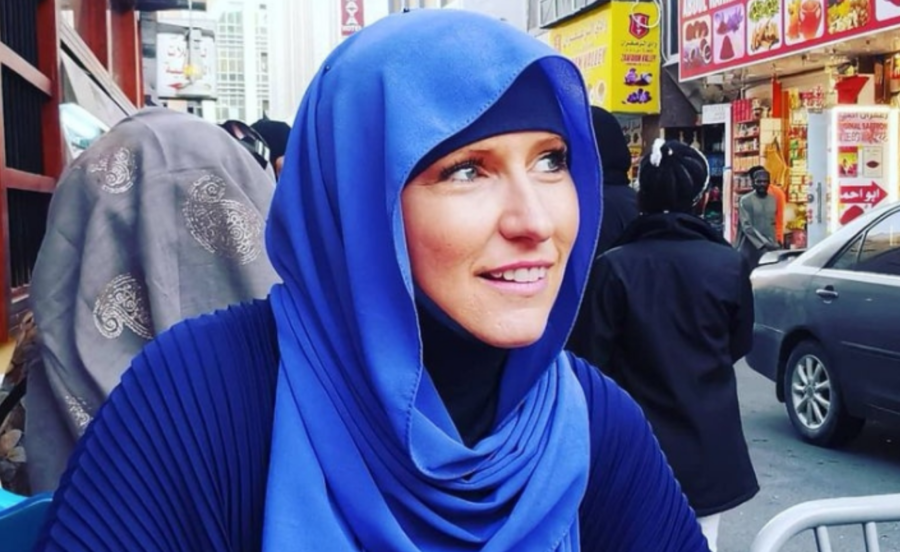
KENOSHA MUSLIM REVERT* FINDS INTERNATIONAL ACCLAIM THROUGH ART
Precious gems seem to be found only in far-off lands. But occasionally, some may be sitting in your own backyard.
Take Jaime Brown, an internationally renowned mural artist who lives right here in Kenosha. Her colorful murals brighten Nova Scotia, the United Arab Emirates, Morocco, Canada and most recently Wisconsin, USA.
In 2020, the Kenosha native and her collaborator Karim Jabbari created three prominent murals: “KINOJE” in Kenosha, “Waves of Giving” in Janesville and “Kindred” in Milwaukee. Brown was commissioned to create her Milwaukee mural on the 2nd Street skywalk after an extensive, competitive international bidding process. “Kindred” celebrates the connections between the neighborhood’s and Brown’s own Native American heritage.
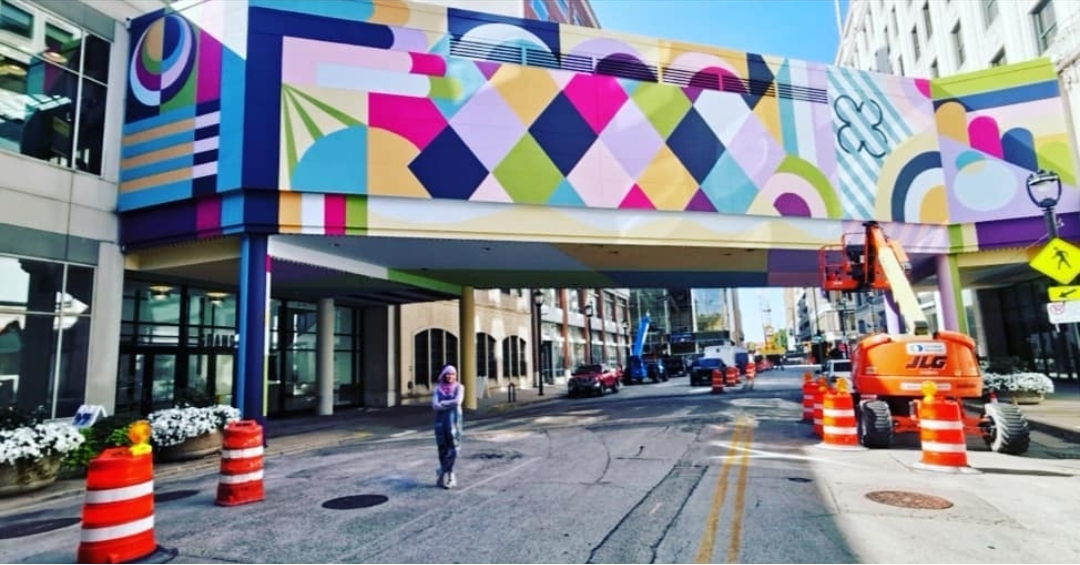
Jaime Brown won a competitive bidding process to create her mural “Kindred” on Milwaukee’s 2nd Street skywalk.
“Within that mural, I hid several symbols from Native American culture,” Brown explained in an interview with the Wisconsin Muslim Journal. “To the regular passerby, it just looks like bright, vivid geometrical shapes and abstract patterns. But there is a meaning behind a lot of what is in that mural.
“I spent a lot of time thinking about what I wanted to do and how I wanted it to look. And when I submitted my proposal, I had a really good feeling about it. I said, ‘Bismillah,’ and clicked send. ‘Ok. We’ll see what happens now. It’s in God’s hands.’”
But before this diamond sparkled through her public art, Brown became a Muslim. Her new faith returned her to her roots. She began creating her own authentic art.
So, sit back and enjoy this true tale of a young Kenosha woman who made it big in the entertainment industry only to abandon the Hollywood highlife to pursue Islam in Morocco, then became an internationally acclaimed artist.
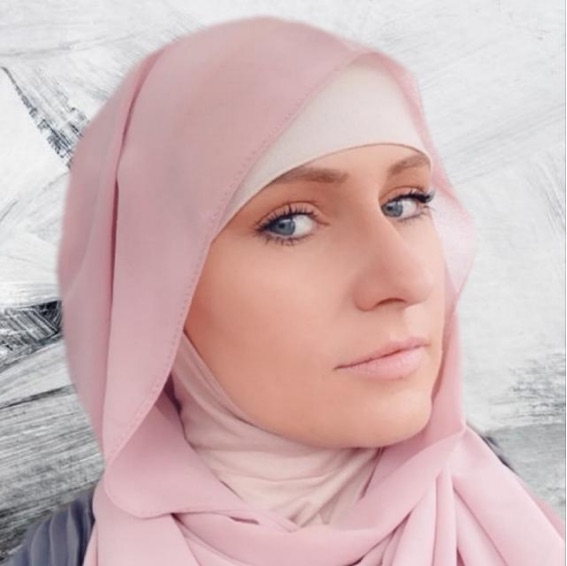
Jaime Brown of Kenosha left a successful career in Hollywood to learn about Islam.
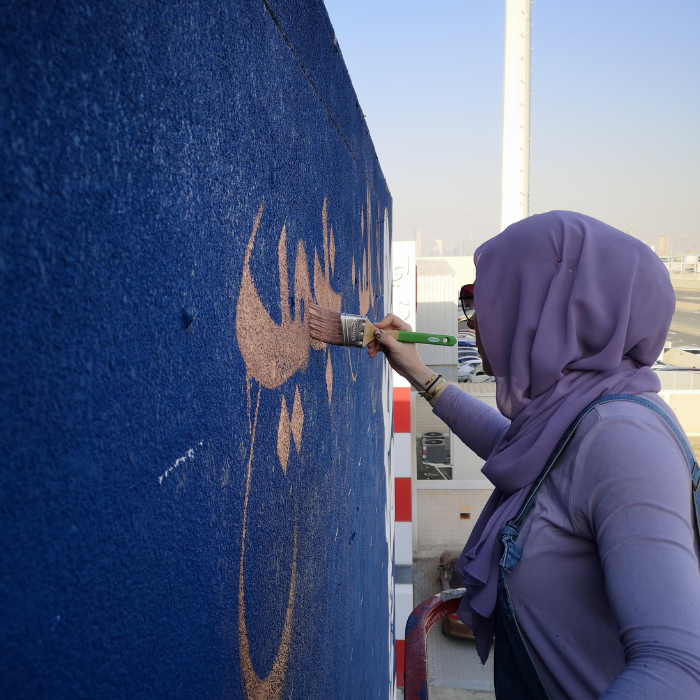
Jaime Brown paints a mural in Dubai.
Growing up curious and creative
In the interview in the spacious basement studio below her Kenosha home, the high-spirited, fast-talking artist said she had been a curious child.
Her face is framed by a pastel green headband and black underscarf, draped with a light pink, flowing hijab, looped loosely below her chin. Subtle eyeshadow and light pink lipstick complement her fair skin and bright blue eyes, revealing skills she once used as a professional make-up artist in Hollywood.
As a young child, Brown skipped TV in favor of doing art projects. She sat at the kitchen table with her craft box, influenced by her mother, an artist and accomplished graphic designer. “Her background in calligraphy and love of typography rubbed off on me,” Brown wrote on her website.
She also had a strong urge to find the right faith from a young age. “I’m talking second and third grade,” Brown said. “Why I had that inside me is something only Allah knows.”
Brown rode her bike to the library and pulled out books on each religion she found. She didn’t want to be Catholic just because her family was. She wanted to learn herself, she said. She didn’t come across any books on Islam at the time.
“I was raised Catholic, baptized as a Methodist and my best friend was Mormon, so I used to go to seminary with her in the mornings before school,” she recalled. “My other best friend was Methodist and I used to sleep at her house – on purpose – on Saturday night so I could go to church with them. I was always looking for the truth.”
Brown ended up joining a non-denominational Christian church. “Everything I found was almost true, but nothing really ever made full sense to me. For me, Christianity was the closest I could get,” she said. She decided that “unless something better comes around, I’m going to stick with this.”
Encountering Islam in Hollywood
Always adventurous, Brown moved on her own to California after college to be a stylist in Hollywood. Once she was there, she observed production work on movie sets and decided to learn those skills. Gradually, she began working in production for TV, film, commercials and music videos.
Eventually, she was working with celebrities, living in Beverly Hills and driving a Jaguar. “I hand painted a KISS logo on a pair of bowling shoes to give Gene Simmons at a surprise birthday party at Lucky Strike, a Hollywood bowling alley and bar frequented by celebrities.
“I was doing all these things everybody said was so cool, but I was not impressed by any of that,” she recalled.
When working in production on an HBO series, she had a colleague who left on Fridays to go to Jummah prayers. She learned he was Muslim and tried to convince him to go to church with her. He refused.
“I didn’t know anything. I was very Christian at the time. I was coming from Kenosha where I taught Sunday school and went to church activities even on Thursday nights.
“I can usually convince people to come to church with me, so I was surprised he was so stubborn. That peaked my curiosity. What is it about your faith that has you so glued to it and what is it that all you Muslims are even doing anyway?
“I had no clue about Islam, only the garbage we see on TV portraying Muslims in a terrible light. But that didn’t make sense because what I saw on TV and his behavior at work didn’t match up at all.
“So, I asked him if I could borrow his book. I thought I was going to read it and tell him why it didn’t make sense and why he should come to Jesus.”
Brown started reading the Quran and was “shocked to find it was very similar to the Bible.” As she kept reading, “it became more and more clear to me that this was the truth I had been searching for since childhood.”
Leaving Hollywood behind
Brown knew she had to leave Hollywood, she said. “My lifestyle there was not cohesive with Islam. ‘If my surroundings are going to change who I am, then I need to change my surroundings,’ I thought. I wanted to go to a Muslim place and be around Muslim people.”
So, in her mid-twenties, she “packed everything into one suitcase and bought a one-way ticket to Morocco and just decided to plop down there and see what happens. I didn’t know what to expect and had no idea what I was getting myself into.”
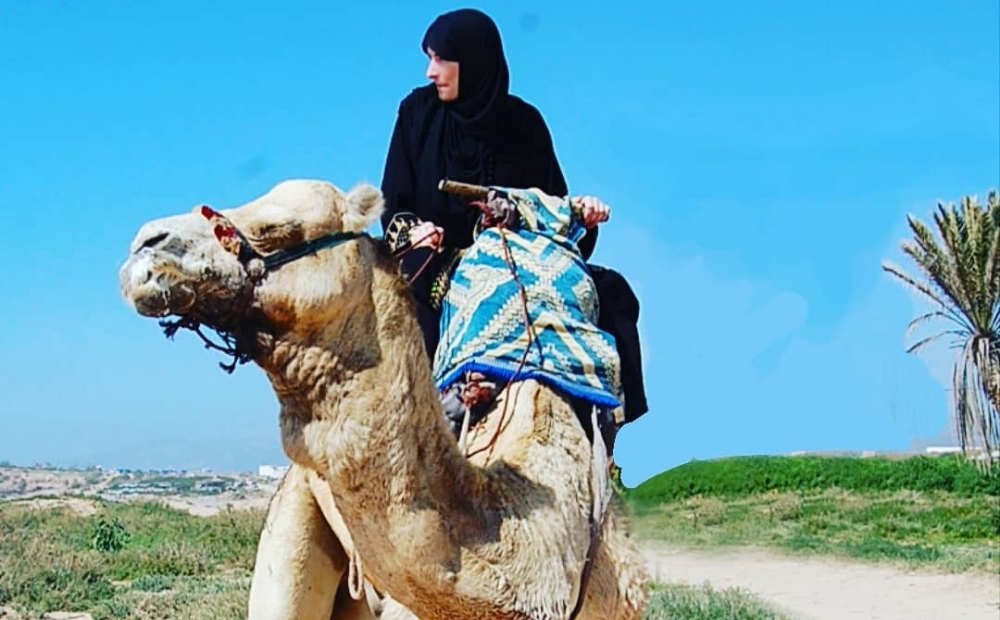
Jaime Brown atop a camel in Agadir, Morocco.
Why Morocco? She didn’t know anyone there or even much about the country. She didn’t speak Arabic or French.
“Everybody asks me that and I have no answer,” she said. “It was so obvious and so clear that it was supposed to be Morocco. Every time I read the Quran, after I was done, I would start thinking about Morocco. What started as a whisper became a full-on shout.”
When Brown arrived in Morocco, “people were like, ‘You left Beverly Hills to come live in a third world country? Are you insane?’ But for me, I didn’t care about any of those worldly things. It was an easy choice.”
“It was an easy choice for her,” interjected Jabbari, who also participated in the interview. “But sometimes we see people who are born Muslims and they know nothing about Islam. Or they know what they should do and they do the opposite.
“I see immense courage in her. She took a risk that most of us would not take. She had this life everyone dreams of. She left it and went to Morocco where there are people dreaming about this glittery life in Los Angeles, working in Hollywood and all that.
“I see this lady who had this amazing lifestyle leave Hollywood because Allah subhanahu wa ta’alallah put the light of iman, faith, in her heart and while on the plane, she made up her mind that this was the right decision she was making, that she was going to be a Muslim for the rest of her life. And I believe that helped her rediscover herself as an artist.”
In Morocco, shortly after Brown arrived and had finished reading the entire Quran, she made her Shahada, her oath to Islam. “I wanted to finish the Quran first just to make sure there were no surprises, like something in the last surah I couldn’t accept,” she said.
Life in Morocco
Brown spent five years in a Moroccan city off the beaten path, “just wandering in different mosques and doing my thing,” she said. She watched how people prayed. She talked to anyone she could to learn more about Islam and spent most of her time studying the faith.
Before Air B n’ B, there was a website called “Couch Surfing” for travelers who wanted to experience a country with local people rather than in a hotel with a brochure and itinerary. Through it, families offered free accommodations in their homes.
“The problem in Morocco was that there are no females who did this,” Brown said. “They were either unmarried and lived at home with mom and dad, and their parents would obviously say no to random Westerners coming in their Muslim home and possibly drinking or smoking or who knows what. Or they were married and their husbands were saying the same thing. There were really no girls. I was one of the few, literally a handful, in Morocco.”
She met other travelers, especially Americans, and helped translate. She also used her background as a hairdresser to do haircuts. Occasionally, Brown did graphic design projects. She found she could make the money she earned go a long way in Morocco.
Through immersion, Brown taught herself Moroccan Arabic. She wrote down new words she learned each day and reviewed them at night. As she got to know locals, they helped her learn to say things correctly.
Returning home to Wisconsin
Brown returned to Kenosha at the end of 2015 and established her home base, though it wasn’t long before her growing international reputation meant frequent travel.
“I have an art studio in my basement and I started spending more and more time down here. I started feeling like myself again. It feels so good to hold a brush and to just go buy paint, just feel all this again,” she said. During her years in Morocco, art supplies were both expensive and hard to find.
“I started getting back into painting. I wasn’t really pursuing murals as a full-time thing and it turned into that unexpectedly, thanks to Karim,” she said, referring to Jabbari who is an internationally renowned calligraphy and light artist, and is recognized among the top 30 public artists in the world.
“We found each other on Instagram. Neither of us remembers who was first but I really liked his art. There is a piece at Curtin University in Australia. I was seeing his notifications and I clicked on it and my jaw dropped.
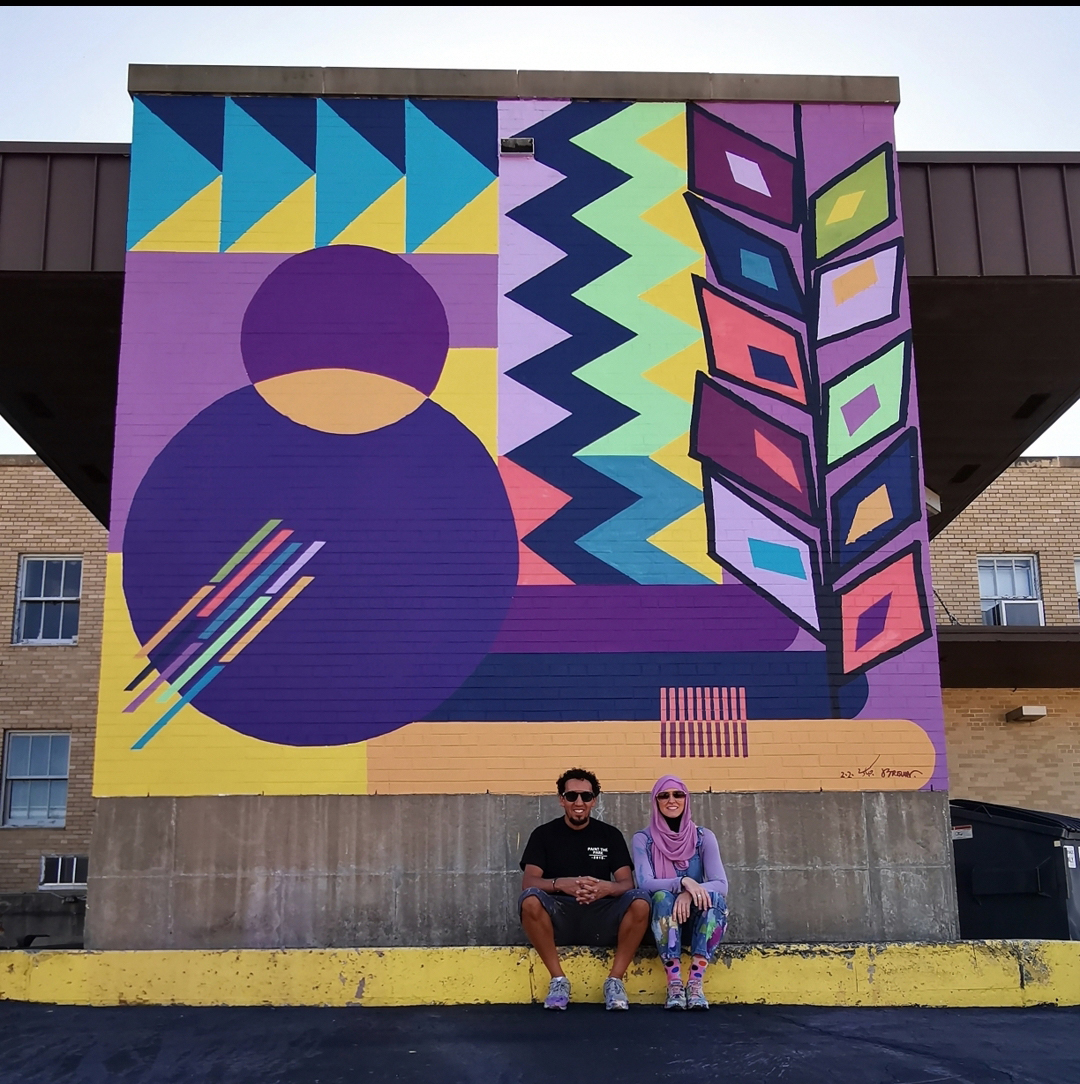
Karim Jabbari and Jaime Brown sit in front of “Waves of Giving” in Janesville.
“Oh my goodness! Who is this talented man? He is phenomenal. I remember I tagged my mom and said, ‘Mom you have to check this artist out.’ My mom is a calligraphy artist as well. ‘You have to see this. This is mind-blowing, unbelievable.’”
Jabbari and Brown exchanged a few messages and “I said, ‘Listen, I’d love to collaborate on a project.’ At that point, I was running a T-shirt business.
“‘How would you feel if we put some of your designs on T-shirts? We can partner up as a collaboration and split the profits.’
“‘That sounds really cool,’” he said.
After a few exchanges, Brown asked Jabbari if she could work with his manager to set everything up. That’s when she discovered his manager had recently quit to raise her family.
“I can manage you remotely if you are looking for someone,” she offered. “I love art and I can do this, no problem.”
He accepted. She managed him remotely. Then he had a mural and live light painting project in Bahrain and asked her to go manage logistics.
“I ended up going there and that’s when our art started to fuse together,” Brown said. “It led to several other projects. He brought me on a few. There was a project in Canada where I was assisting him on a mural and he said, ‘Hey, there is some extra wall space. Would you like to do it?’
“‘Yeah, of course I want to do that!’ I just put on my headphones and got to work. I didn’t have a plan. I just freestyled it and ended up painting this whole staircase. He came over and said, ‘Well, well, well, looky here!’
“One project we did together that I really like was in Dubai,” said Brown. “It was the first mural in their arts district, al Quoz. We both contributed style-wise. Karim came up with the design and he asked me for my input about the colors. It was fun because he got to do one element of it then I added my input for another element.”
“I see a lot of talent in her,” Jabbari said. “I try to guide her without pushing her. I want her to discover what she likes to do.
“Then she turned out to be this amazing mural artist with a lot of talent. With every project she does, people are surprised by the beauty of her work and the amount of detail and perfection it has.
“It is a pleasure for me to work with her. I am usually in the driver’s seat but sometimes with her, I’m the assistant and I love it.”
“It feels weird for me too,” Brown added. “I started off assisting him and then he is assisting me and I’m like, ‘No! You’re the big famous worldwide artist. Why are you assisting me?’
“It’s nice because we have two completely different art styles yet we can help each other easily. And I can do everything except when he does his fabulous calligraphy.”
Brown said she enjoys the “unspoken dawah” being a street artist creates. “It is important to show people that just because I am a Muslim, and especially because I wear hijab, that does not limit me or stop me from anything.
“Yes, it’s 94 degrees up on the lift in the dead heat of August. And yes, I’m hot in my full overalls, headband, underscarf, scarf, and longsleeves I can’t roll up. I’m dying on this lift. But I don’t care because I’m so happy and so in the place where I want to be.”
Follow Jaime Brown on Instagram for her latest art to home remodeling to Muslim fashion tips and more.
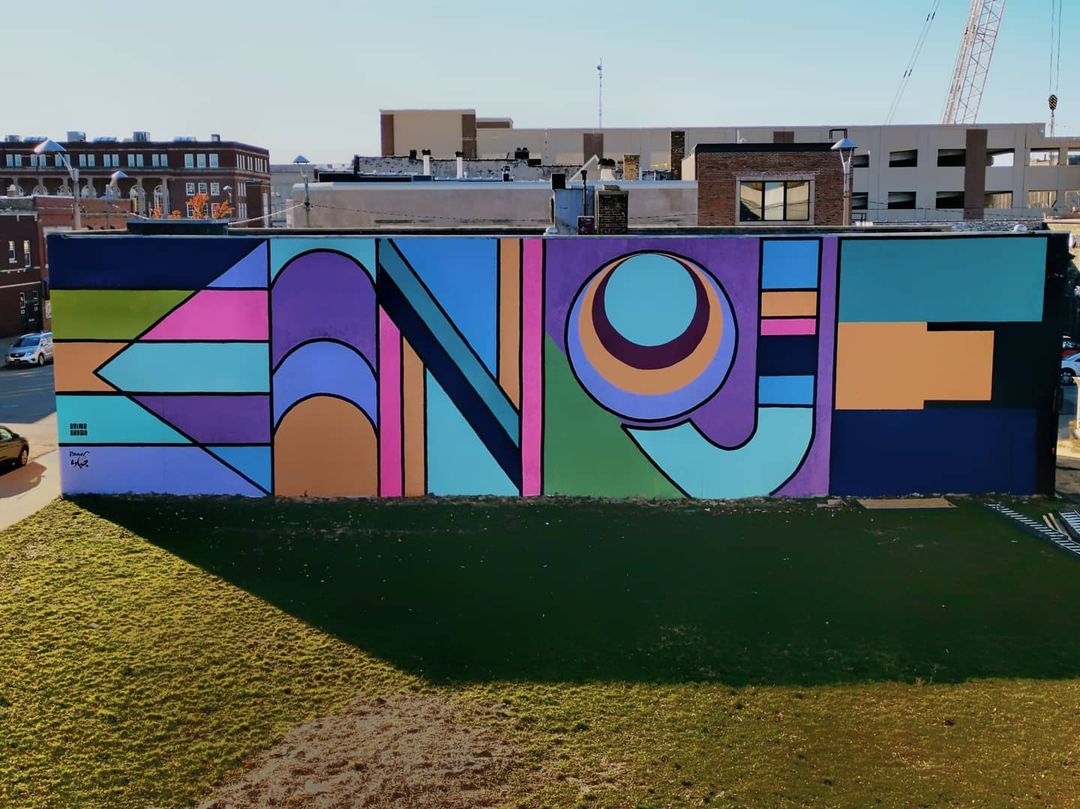
Brown’s KINOJE is featured in Kenosha Creative Space, 624 57th Street.
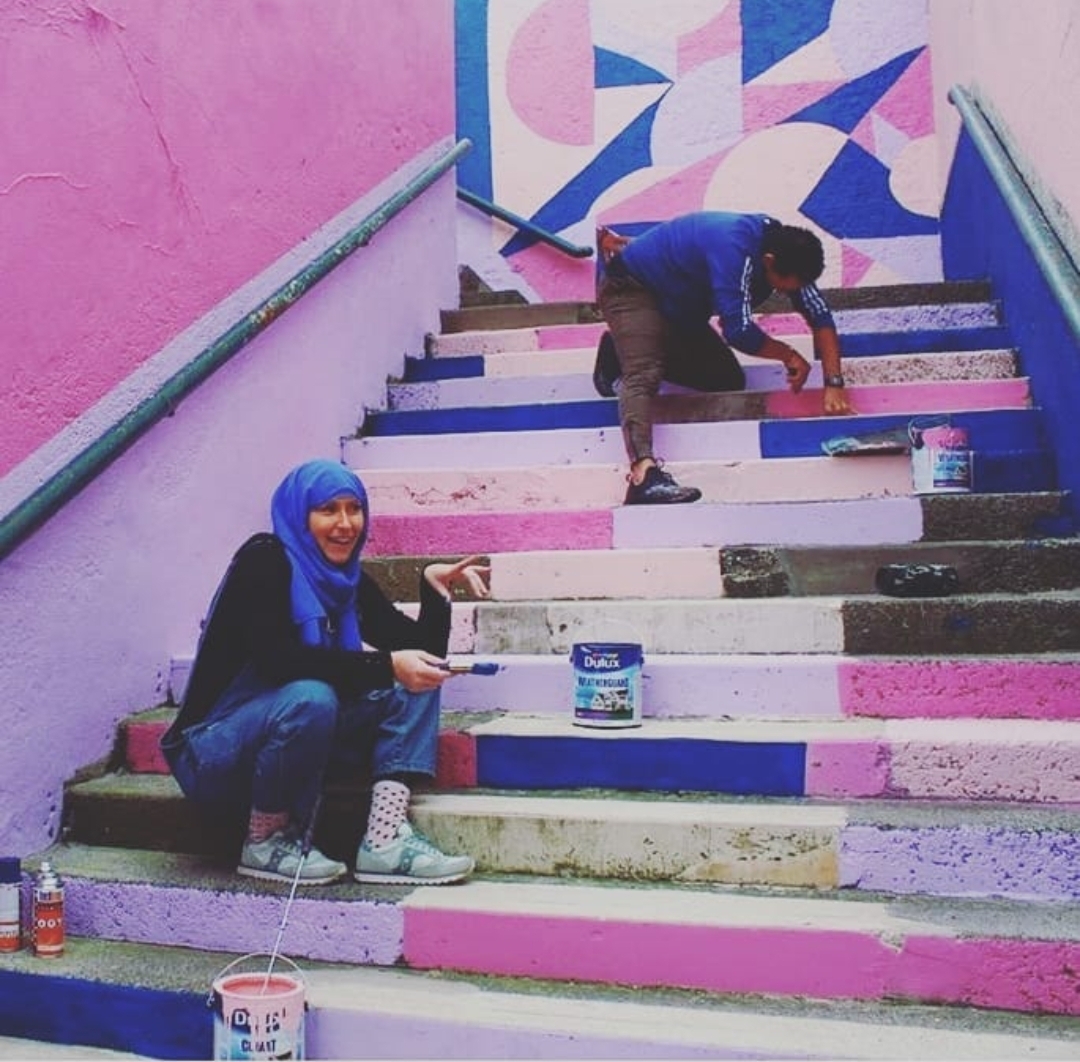
Jaime Brown and Karim Jabbari paint “Cotton Candy Stairs” in Halifax, Nova Scotia.
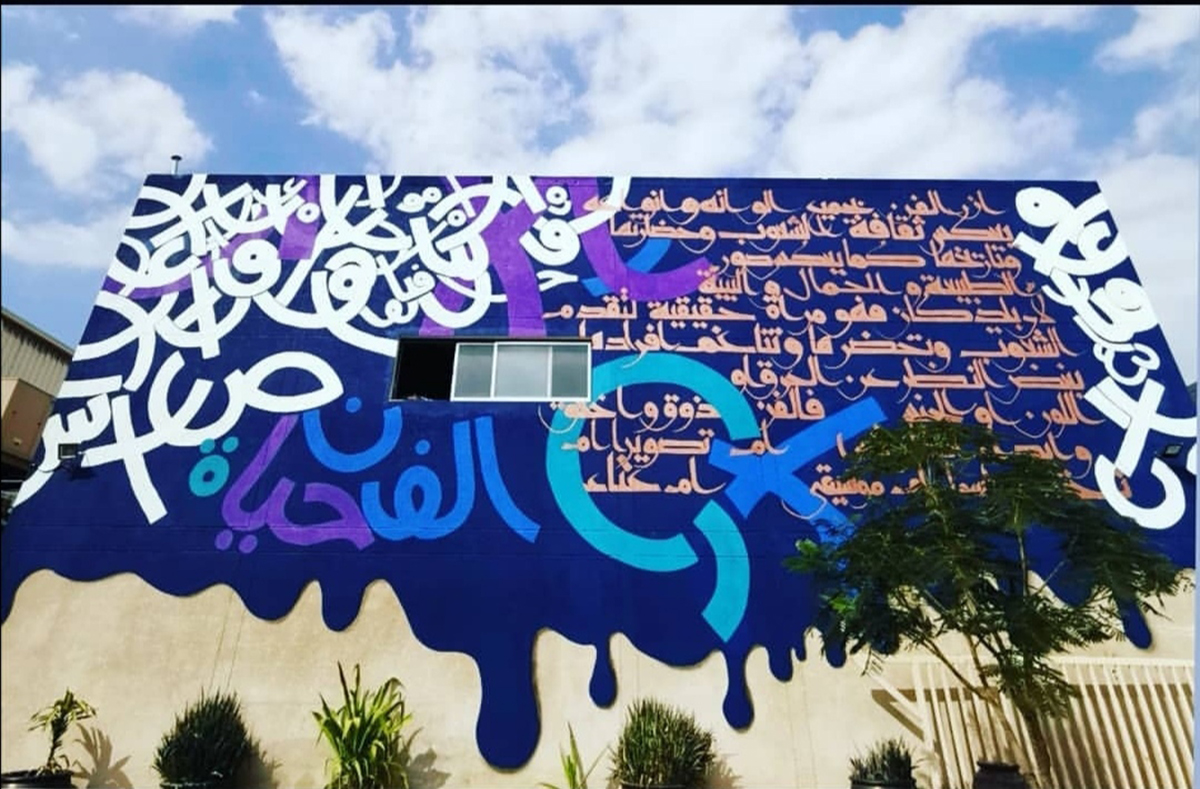
Jaime Brown collaborated with Karim Jabbari on a mural in Dubai.
SOURCE: https://wisconsinmuslimjournal.org/kenosha-muslim-revert-finds-international-acclaim-through-art/

